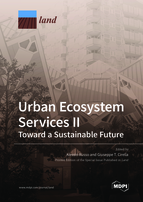Urban Ecosystem Services II: Toward a Sustainable Future
A special issue of Land (ISSN 2073-445X). This special issue belongs to the section "Urban Contexts and Urban-Rural Interactions".
Deadline for manuscript submissions: closed (15 July 2021) | Viewed by 49470
Special Issue Editors
Interests: urban ecosystem services and disservices; nature-based solutions; biophilic urbanism; urban ecology; green infrastructure; urban agriculture; urban green spaces and health; ecological landscape design; sustainable planning; cultural landscapes; landscape architecture
Special Issues, Collections and Topics in MDPI journals
Interests: geography; sustainability; environmental management; urban studies; social impact; economic development; green infrastructure
Special Issues, Collections and Topics in MDPI journals
Special Issue Information
Dear Colleagues,
We are pleased to announce the Special Issue of Land on “Urban Ecosystem Services II”.
Urbanization, growth population and climate change have negative impacts on ecosystem services (ES) in cities. Assessing as well as estimating the losses of ES due to rapid urban expansion plays a significant role in sustainable urban development [4]. However, studies on the effects of urbanization on ES have shown inconsistent and, in some cases, contradictory results [1–3].
Modern compact cities have been identified as having a high-density and mixed-use pattern. Their features are believed to contribute to a form of functional urban design that supports sustainability and restresses the importance of ES. The urban green space plays a vital role in the design and impact on how compact cities have developed, and thus, a scientific discord on the amount of greenery individuals require and to what extent contemporary approaches address this has been triggered. Therefore, future cities should integrate social-ecological systems into urban planning, management, and governance [3,5].
This Special Issue aims to explore innovative approaches for enhancing urban sustainability and ES in the face of increasing urbanization concerns. Areas of interest include, but are not limited to, the following:
- Assessing natural capital and ecosystem services;
- Compact cities;
- Ecology in cities;
- Ecosystem services, ecosystem disservices, and well-being;
- Ecosystem service degradation;
- Edible green infrastructure;
- Green infrastructure;
- Green space;
- Green walls;
- Healing garden design;
- Landscape architecture and urban design;
- Mapping and assessing ecosystem services;
- Modelling ecosystem services;
- Nature-based solutions;
- Social-ecological systems;
- Sustainable urbanism;
- Urban agriculture;
- Urban biodiversity and ecosystem services;
- Urban biosphere reserve;
- Urban ecosystems;
- Urban forest;
- Urban geography and development;
- Urban–rural interface;
- Urban sustainability.
References
- Wang, J.; Zhou, W.; Pickett, S.T.A.; Yu, W.; Li, W. A multiscale analysis of urbanization effects on ecosystem services supply in an urban megaregion. Sci. Total Environ. 2019, 662, 824–833.
- Russo, A.; Cirella, G.T. Edible Green Infrastructure 4.0 for Food Security and Well-being: Campania Region, Italy. In International Guidelines on Urban and Territorial Planning. Compendium of Inspiring Practices: Health Edition; Quinlan, V., Ed.; UN Habitat, HS/080/18E: Nairobi, Kenya, 2018; p. 72.
- Russo, A.; Cirella, G.T. Modern Compact Cities: How Much Greenery Do We Need? Int. J. Environ. Res. Public Health 2018, 15, 2180.
- Das, M.; Das, A. Dynamics of Urbanization and its impact on Urban Ecosystem Services (UESs): A study of a medium size town of West Bengal, Eastern India. J. Urban Manag. 2019, 1–15.
- Schewenius, M.; McPhearson, T.; Elmqvist, T. Opportunities for Increasing Resilience and Sustainability of Urban Social–Ecological Systems: Insights from the URBES and the Cities and Biodiversity Outlook Projects. Ambio 2014, 43, 434–444.
Dr. Alessio Russo
Prof. Dr. Giuseppe T. Cirella
Guest Editors
Manuscript Submission Information
Manuscripts should be submitted online at www.mdpi.com by registering and logging in to this website. Once you are registered, click here to go to the submission form. Manuscripts can be submitted until the deadline. All submissions that pass pre-check are peer-reviewed. Accepted papers will be published continuously in the journal (as soon as accepted) and will be listed together on the special issue website. Research articles, review articles as well as short communications are invited. For planned papers, a title and short abstract (about 100 words) can be sent to the Editorial Office for announcement on this website.
Submitted manuscripts should not have been published previously, nor be under consideration for publication elsewhere (except conference proceedings papers). All manuscripts are thoroughly refereed through a single-blind peer-review process. A guide for authors and other relevant information for submission of manuscripts is available on the Instructions for Authors page. Land is an international peer-reviewed open access monthly journal published by MDPI.
Please visit the Instructions for Authors page before submitting a manuscript. The Article Processing Charge (APC) for publication in this open access journal is 2600 CHF (Swiss Francs). Submitted papers should be well formatted and use good English. Authors may use MDPI's English editing service prior to publication or during author revisions.
Keywords
- urbanization
- ecosystem services
- urban ecology
- green infrastructure
- green space
- resiliency
- sustainability
- urban trees
Related Special Issues
- Urban Ecosystem Services III in Land (12 articles)
- Urban Ecosystem Services IV in Land (10 articles)
- Urban Ecosystem Services in Land (13 articles)







